NURS5082 Case Study: Pre- and Post-Operative Care for Bowel Resection
VerifiedAdded on 2023/01/04
|9
|2692
|67
Case Study
AI Summary
This case study focuses on the nursing care of a 50-year-old patient, Charles, admitted for a bowel resection due to Crohn's disease. The assignment addresses pre-operative assessment, emphasizing the significance of physical examinations, vital sign monitoring, and addressing potential risks like hypertension. It also examines post-operative complications, particularly nutritional imbalance in the first 48 hours after surgery. The study delves into nursing interventions for managing nutritional deficiencies, including intravenous fluid therapy, monitoring blood parameters (hemoglobin, total protein), and dietary planning. The evaluation of nursing interventions involves monitoring blood serum parameters, visual assessments, and muscle mass analysis. The case study underscores the importance of evidence-based practice in providing holistic patient care throughout the surgical journey.
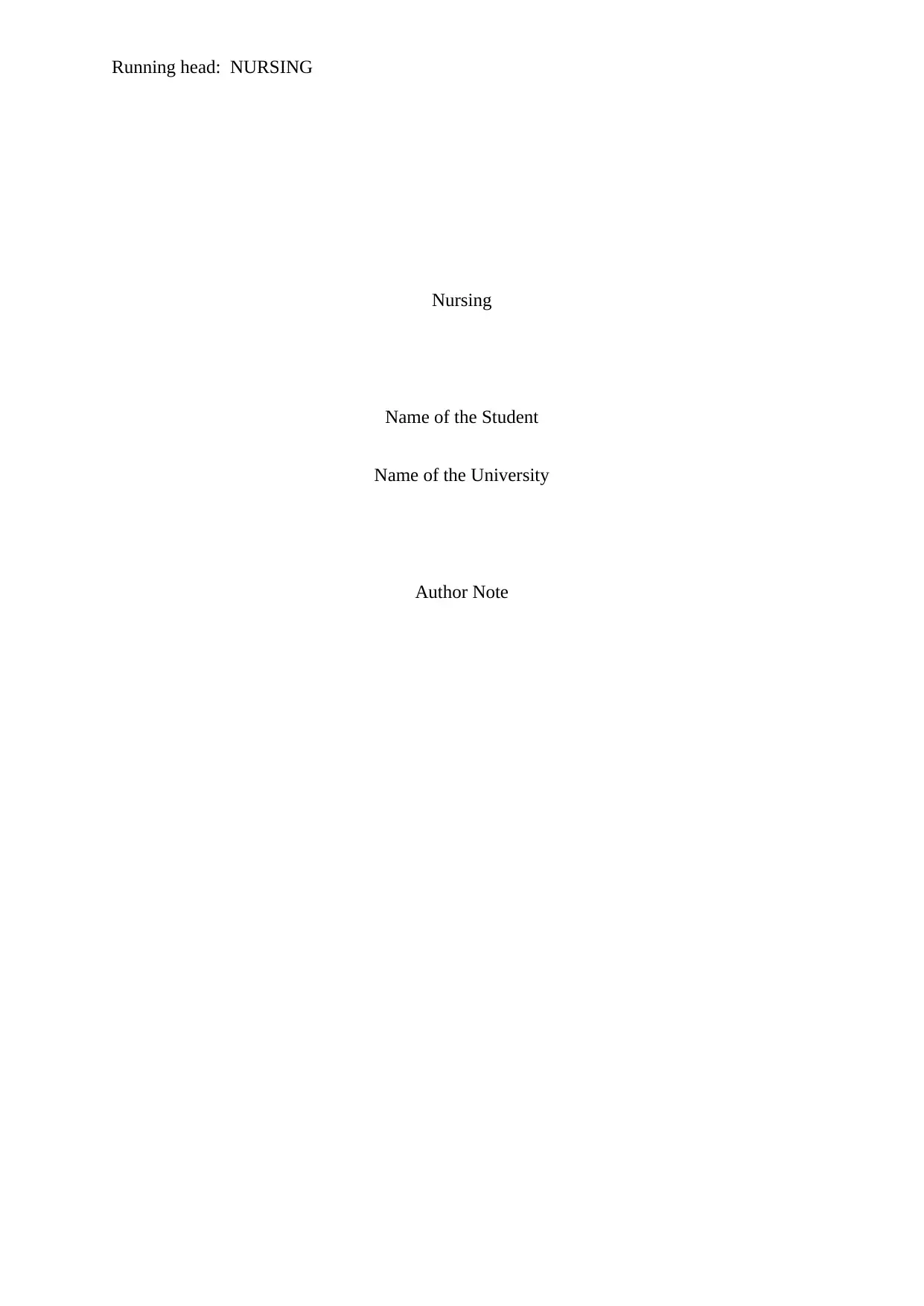
Running head: NURSING
Nursing
Name of the Student
Name of the University
Author Note
Nursing
Name of the Student
Name of the University
Author Note
Paraphrase This Document
Need a fresh take? Get an instant paraphrase of this document with our AI Paraphraser
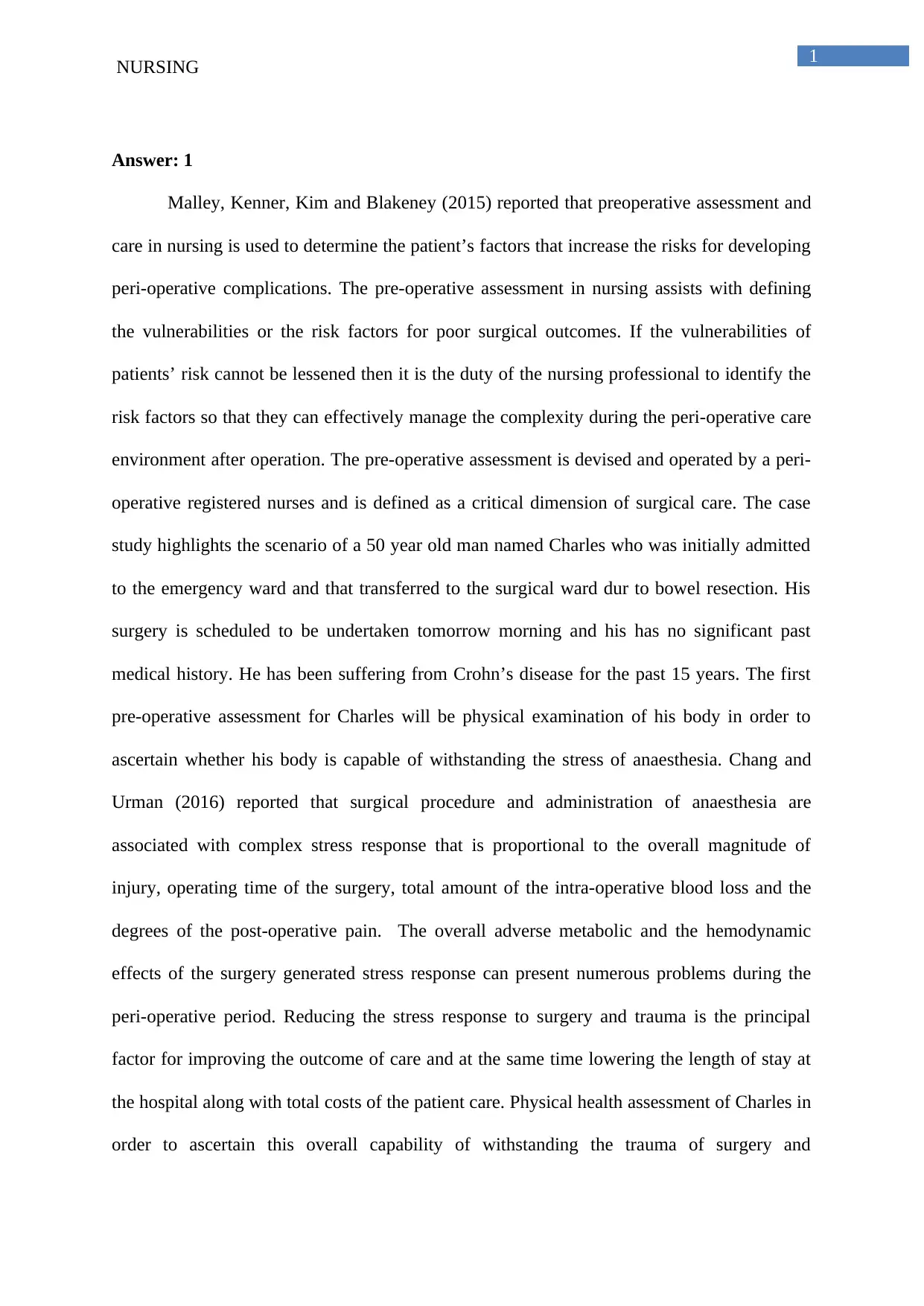
1
NURSING
Answer: 1
Malley, Kenner, Kim and Blakeney (2015) reported that preoperative assessment and
care in nursing is used to determine the patient’s factors that increase the risks for developing
peri-operative complications. The pre-operative assessment in nursing assists with defining
the vulnerabilities or the risk factors for poor surgical outcomes. If the vulnerabilities of
patients’ risk cannot be lessened then it is the duty of the nursing professional to identify the
risk factors so that they can effectively manage the complexity during the peri-operative care
environment after operation. The pre-operative assessment is devised and operated by a peri-
operative registered nurses and is defined as a critical dimension of surgical care. The case
study highlights the scenario of a 50 year old man named Charles who was initially admitted
to the emergency ward and that transferred to the surgical ward dur to bowel resection. His
surgery is scheduled to be undertaken tomorrow morning and his has no significant past
medical history. He has been suffering from Crohn’s disease for the past 15 years. The first
pre-operative assessment for Charles will be physical examination of his body in order to
ascertain whether his body is capable of withstanding the stress of anaesthesia. Chang and
Urman (2016) reported that surgical procedure and administration of anaesthesia are
associated with complex stress response that is proportional to the overall magnitude of
injury, operating time of the surgery, total amount of the intra-operative blood loss and the
degrees of the post-operative pain. The overall adverse metabolic and the hemodynamic
effects of the surgery generated stress response can present numerous problems during the
peri-operative period. Reducing the stress response to surgery and trauma is the principal
factor for improving the outcome of care and at the same time lowering the length of stay at
the hospital along with total costs of the patient care. Physical health assessment of Charles in
order to ascertain this overall capability of withstanding the trauma of surgery and
NURSING
Answer: 1
Malley, Kenner, Kim and Blakeney (2015) reported that preoperative assessment and
care in nursing is used to determine the patient’s factors that increase the risks for developing
peri-operative complications. The pre-operative assessment in nursing assists with defining
the vulnerabilities or the risk factors for poor surgical outcomes. If the vulnerabilities of
patients’ risk cannot be lessened then it is the duty of the nursing professional to identify the
risk factors so that they can effectively manage the complexity during the peri-operative care
environment after operation. The pre-operative assessment is devised and operated by a peri-
operative registered nurses and is defined as a critical dimension of surgical care. The case
study highlights the scenario of a 50 year old man named Charles who was initially admitted
to the emergency ward and that transferred to the surgical ward dur to bowel resection. His
surgery is scheduled to be undertaken tomorrow morning and his has no significant past
medical history. He has been suffering from Crohn’s disease for the past 15 years. The first
pre-operative assessment for Charles will be physical examination of his body in order to
ascertain whether his body is capable of withstanding the stress of anaesthesia. Chang and
Urman (2016) reported that surgical procedure and administration of anaesthesia are
associated with complex stress response that is proportional to the overall magnitude of
injury, operating time of the surgery, total amount of the intra-operative blood loss and the
degrees of the post-operative pain. The overall adverse metabolic and the hemodynamic
effects of the surgery generated stress response can present numerous problems during the
peri-operative period. Reducing the stress response to surgery and trauma is the principal
factor for improving the outcome of care and at the same time lowering the length of stay at
the hospital along with total costs of the patient care. Physical health assessment of Charles in
order to ascertain this overall capability of withstanding the trauma of surgery and
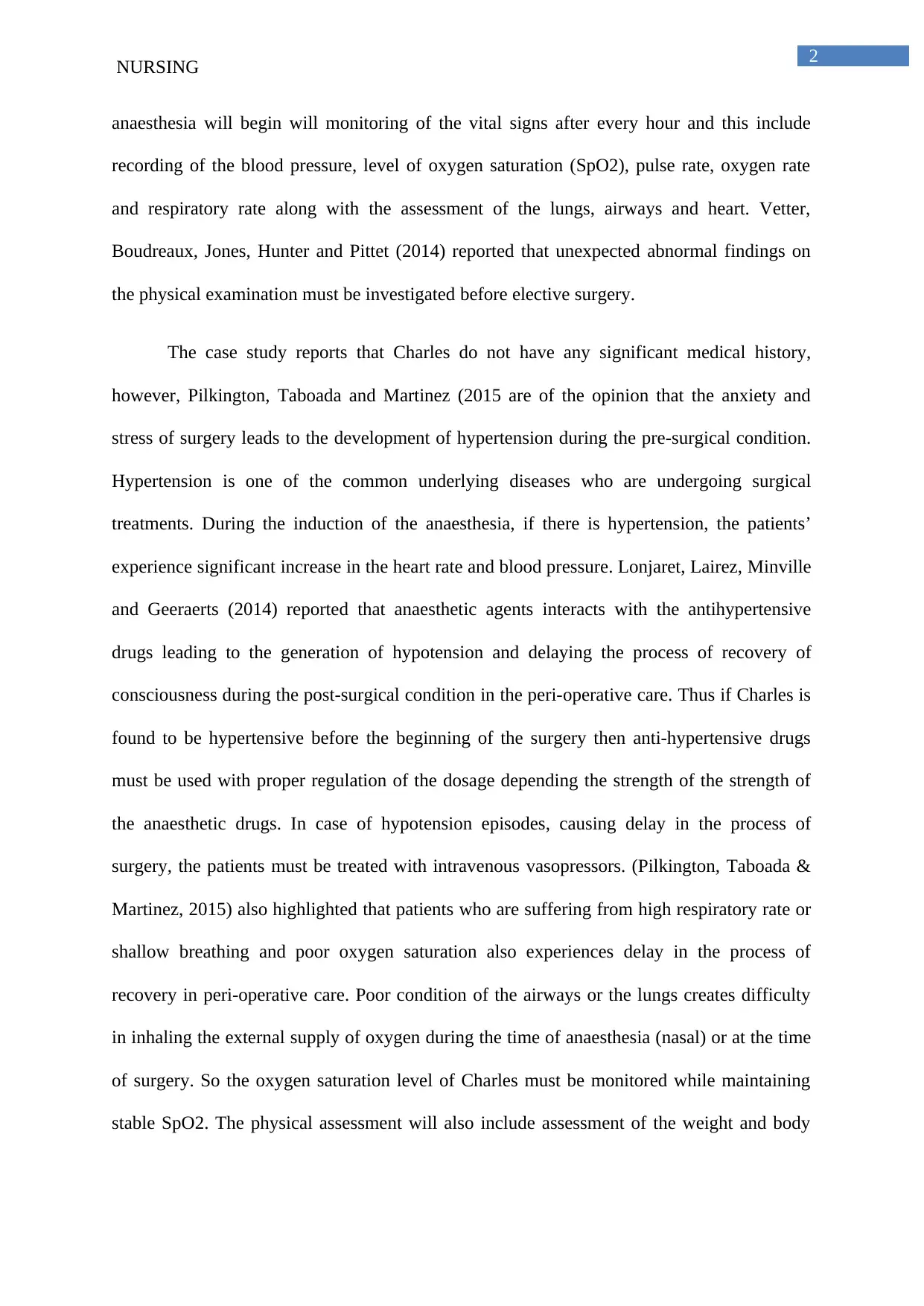
2
NURSING
anaesthesia will begin will monitoring of the vital signs after every hour and this include
recording of the blood pressure, level of oxygen saturation (SpO2), pulse rate, oxygen rate
and respiratory rate along with the assessment of the lungs, airways and heart. Vetter,
Boudreaux, Jones, Hunter and Pittet (2014) reported that unexpected abnormal findings on
the physical examination must be investigated before elective surgery.
The case study reports that Charles do not have any significant medical history,
however, Pilkington, Taboada and Martinez (2015 are of the opinion that the anxiety and
stress of surgery leads to the development of hypertension during the pre-surgical condition.
Hypertension is one of the common underlying diseases who are undergoing surgical
treatments. During the induction of the anaesthesia, if there is hypertension, the patients’
experience significant increase in the heart rate and blood pressure. Lonjaret, Lairez, Minville
and Geeraerts (2014) reported that anaesthetic agents interacts with the antihypertensive
drugs leading to the generation of hypotension and delaying the process of recovery of
consciousness during the post-surgical condition in the peri-operative care. Thus if Charles is
found to be hypertensive before the beginning of the surgery then anti-hypertensive drugs
must be used with proper regulation of the dosage depending the strength of the strength of
the anaesthetic drugs. In case of hypotension episodes, causing delay in the process of
surgery, the patients must be treated with intravenous vasopressors. (Pilkington, Taboada &
Martinez, 2015) also highlighted that patients who are suffering from high respiratory rate or
shallow breathing and poor oxygen saturation also experiences delay in the process of
recovery in peri-operative care. Poor condition of the airways or the lungs creates difficulty
in inhaling the external supply of oxygen during the time of anaesthesia (nasal) or at the time
of surgery. So the oxygen saturation level of Charles must be monitored while maintaining
stable SpO2. The physical assessment will also include assessment of the weight and body
NURSING
anaesthesia will begin will monitoring of the vital signs after every hour and this include
recording of the blood pressure, level of oxygen saturation (SpO2), pulse rate, oxygen rate
and respiratory rate along with the assessment of the lungs, airways and heart. Vetter,
Boudreaux, Jones, Hunter and Pittet (2014) reported that unexpected abnormal findings on
the physical examination must be investigated before elective surgery.
The case study reports that Charles do not have any significant medical history,
however, Pilkington, Taboada and Martinez (2015 are of the opinion that the anxiety and
stress of surgery leads to the development of hypertension during the pre-surgical condition.
Hypertension is one of the common underlying diseases who are undergoing surgical
treatments. During the induction of the anaesthesia, if there is hypertension, the patients’
experience significant increase in the heart rate and blood pressure. Lonjaret, Lairez, Minville
and Geeraerts (2014) reported that anaesthetic agents interacts with the antihypertensive
drugs leading to the generation of hypotension and delaying the process of recovery of
consciousness during the post-surgical condition in the peri-operative care. Thus if Charles is
found to be hypertensive before the beginning of the surgery then anti-hypertensive drugs
must be used with proper regulation of the dosage depending the strength of the strength of
the anaesthetic drugs. In case of hypotension episodes, causing delay in the process of
surgery, the patients must be treated with intravenous vasopressors. (Pilkington, Taboada &
Martinez, 2015) also highlighted that patients who are suffering from high respiratory rate or
shallow breathing and poor oxygen saturation also experiences delay in the process of
recovery in peri-operative care. Poor condition of the airways or the lungs creates difficulty
in inhaling the external supply of oxygen during the time of anaesthesia (nasal) or at the time
of surgery. So the oxygen saturation level of Charles must be monitored while maintaining
stable SpO2. The physical assessment will also include assessment of the weight and body
⊘ This is a preview!⊘
Do you want full access?
Subscribe today to unlock all pages.

Trusted by 1+ million students worldwide
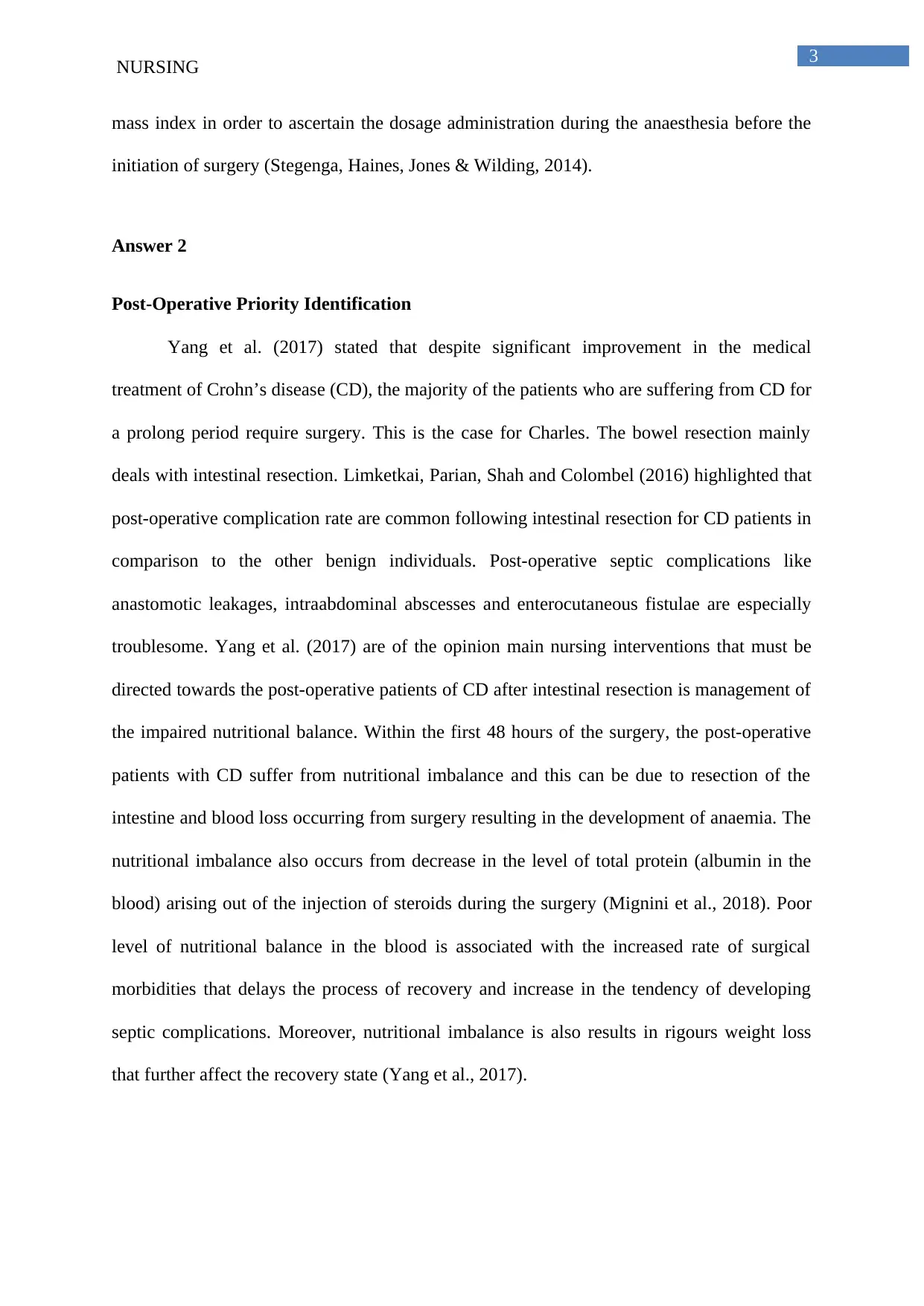
3
NURSING
mass index in order to ascertain the dosage administration during the anaesthesia before the
initiation of surgery (Stegenga, Haines, Jones & Wilding, 2014).
Answer 2
Post-Operative Priority Identification
Yang et al. (2017) stated that despite significant improvement in the medical
treatment of Crohn’s disease (CD), the majority of the patients who are suffering from CD for
a prolong period require surgery. This is the case for Charles. The bowel resection mainly
deals with intestinal resection. Limketkai, Parian, Shah and Colombel (2016) highlighted that
post-operative complication rate are common following intestinal resection for CD patients in
comparison to the other benign individuals. Post-operative septic complications like
anastomotic leakages, intraabdominal abscesses and enterocutaneous fistulae are especially
troublesome. Yang et al. (2017) are of the opinion main nursing interventions that must be
directed towards the post-operative patients of CD after intestinal resection is management of
the impaired nutritional balance. Within the first 48 hours of the surgery, the post-operative
patients with CD suffer from nutritional imbalance and this can be due to resection of the
intestine and blood loss occurring from surgery resulting in the development of anaemia. The
nutritional imbalance also occurs from decrease in the level of total protein (albumin in the
blood) arising out of the injection of steroids during the surgery (Mignini et al., 2018). Poor
level of nutritional balance in the blood is associated with the increased rate of surgical
morbidities that delays the process of recovery and increase in the tendency of developing
septic complications. Moreover, nutritional imbalance is also results in rigours weight loss
that further affect the recovery state (Yang et al., 2017).
NURSING
mass index in order to ascertain the dosage administration during the anaesthesia before the
initiation of surgery (Stegenga, Haines, Jones & Wilding, 2014).
Answer 2
Post-Operative Priority Identification
Yang et al. (2017) stated that despite significant improvement in the medical
treatment of Crohn’s disease (CD), the majority of the patients who are suffering from CD for
a prolong period require surgery. This is the case for Charles. The bowel resection mainly
deals with intestinal resection. Limketkai, Parian, Shah and Colombel (2016) highlighted that
post-operative complication rate are common following intestinal resection for CD patients in
comparison to the other benign individuals. Post-operative septic complications like
anastomotic leakages, intraabdominal abscesses and enterocutaneous fistulae are especially
troublesome. Yang et al. (2017) are of the opinion main nursing interventions that must be
directed towards the post-operative patients of CD after intestinal resection is management of
the impaired nutritional balance. Within the first 48 hours of the surgery, the post-operative
patients with CD suffer from nutritional imbalance and this can be due to resection of the
intestine and blood loss occurring from surgery resulting in the development of anaemia. The
nutritional imbalance also occurs from decrease in the level of total protein (albumin in the
blood) arising out of the injection of steroids during the surgery (Mignini et al., 2018). Poor
level of nutritional balance in the blood is associated with the increased rate of surgical
morbidities that delays the process of recovery and increase in the tendency of developing
septic complications. Moreover, nutritional imbalance is also results in rigours weight loss
that further affect the recovery state (Yang et al., 2017).
Paraphrase This Document
Need a fresh take? Get an instant paraphrase of this document with our AI Paraphraser
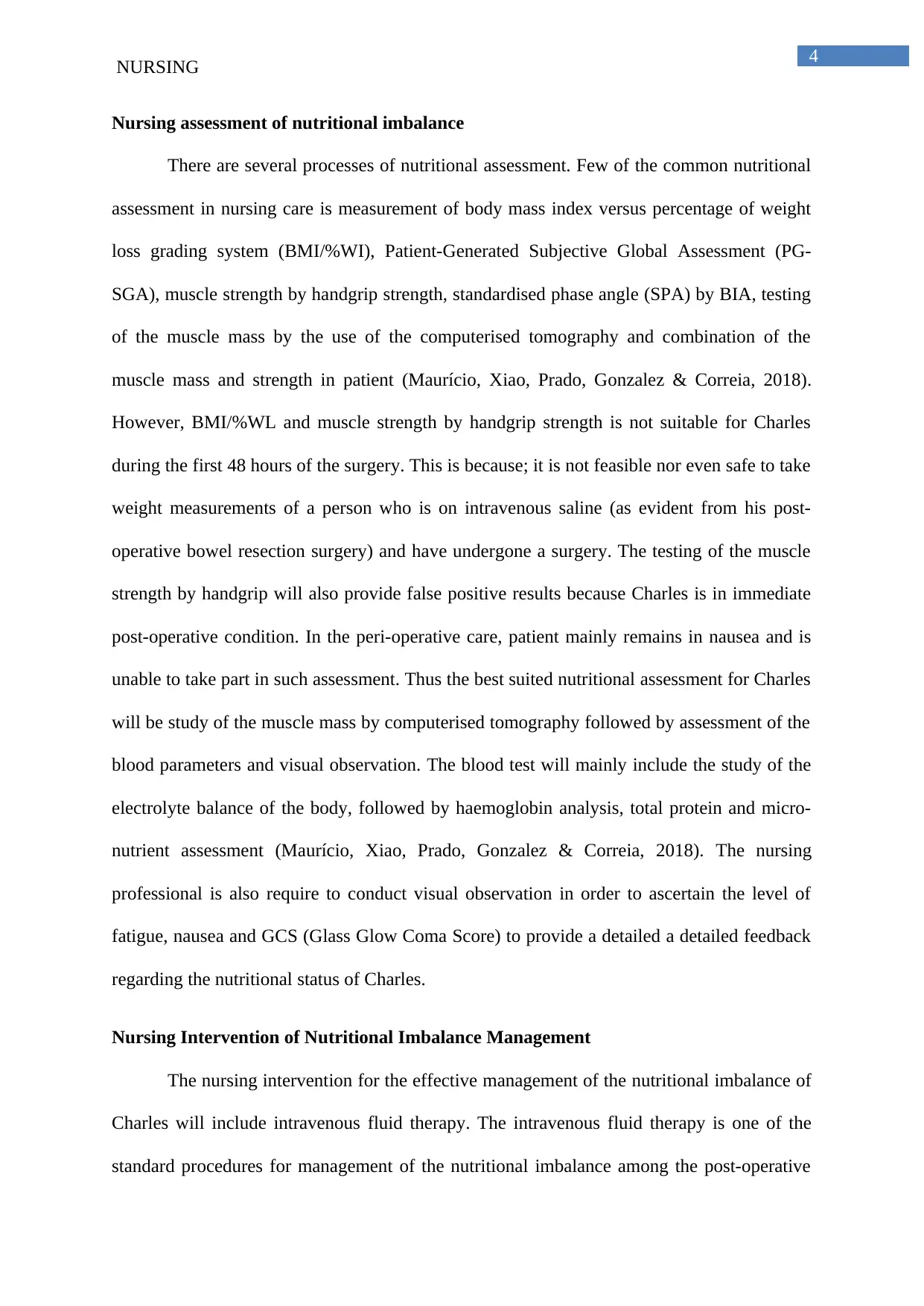
4
NURSING
Nursing assessment of nutritional imbalance
There are several processes of nutritional assessment. Few of the common nutritional
assessment in nursing care is measurement of body mass index versus percentage of weight
loss grading system (BMI/%WI), Patient-Generated Subjective Global Assessment (PG-
SGA), muscle strength by handgrip strength, standardised phase angle (SPA) by BIA, testing
of the muscle mass by the use of the computerised tomography and combination of the
muscle mass and strength in patient (Maurício, Xiao, Prado, Gonzalez & Correia, 2018).
However, BMI/%WL and muscle strength by handgrip strength is not suitable for Charles
during the first 48 hours of the surgery. This is because; it is not feasible nor even safe to take
weight measurements of a person who is on intravenous saline (as evident from his post-
operative bowel resection surgery) and have undergone a surgery. The testing of the muscle
strength by handgrip will also provide false positive results because Charles is in immediate
post-operative condition. In the peri-operative care, patient mainly remains in nausea and is
unable to take part in such assessment. Thus the best suited nutritional assessment for Charles
will be study of the muscle mass by computerised tomography followed by assessment of the
blood parameters and visual observation. The blood test will mainly include the study of the
electrolyte balance of the body, followed by haemoglobin analysis, total protein and micro-
nutrient assessment (Maurício, Xiao, Prado, Gonzalez & Correia, 2018). The nursing
professional is also require to conduct visual observation in order to ascertain the level of
fatigue, nausea and GCS (Glass Glow Coma Score) to provide a detailed a detailed feedback
regarding the nutritional status of Charles.
Nursing Intervention of Nutritional Imbalance Management
The nursing intervention for the effective management of the nutritional imbalance of
Charles will include intravenous fluid therapy. The intravenous fluid therapy is one of the
standard procedures for management of the nutritional imbalance among the post-operative
NURSING
Nursing assessment of nutritional imbalance
There are several processes of nutritional assessment. Few of the common nutritional
assessment in nursing care is measurement of body mass index versus percentage of weight
loss grading system (BMI/%WI), Patient-Generated Subjective Global Assessment (PG-
SGA), muscle strength by handgrip strength, standardised phase angle (SPA) by BIA, testing
of the muscle mass by the use of the computerised tomography and combination of the
muscle mass and strength in patient (Maurício, Xiao, Prado, Gonzalez & Correia, 2018).
However, BMI/%WL and muscle strength by handgrip strength is not suitable for Charles
during the first 48 hours of the surgery. This is because; it is not feasible nor even safe to take
weight measurements of a person who is on intravenous saline (as evident from his post-
operative bowel resection surgery) and have undergone a surgery. The testing of the muscle
strength by handgrip will also provide false positive results because Charles is in immediate
post-operative condition. In the peri-operative care, patient mainly remains in nausea and is
unable to take part in such assessment. Thus the best suited nutritional assessment for Charles
will be study of the muscle mass by computerised tomography followed by assessment of the
blood parameters and visual observation. The blood test will mainly include the study of the
electrolyte balance of the body, followed by haemoglobin analysis, total protein and micro-
nutrient assessment (Maurício, Xiao, Prado, Gonzalez & Correia, 2018). The nursing
professional is also require to conduct visual observation in order to ascertain the level of
fatigue, nausea and GCS (Glass Glow Coma Score) to provide a detailed a detailed feedback
regarding the nutritional status of Charles.
Nursing Intervention of Nutritional Imbalance Management
The nursing intervention for the effective management of the nutritional imbalance of
Charles will include intravenous fluid therapy. The intravenous fluid therapy is one of the
standard procedures for management of the nutritional imbalance among the post-operative
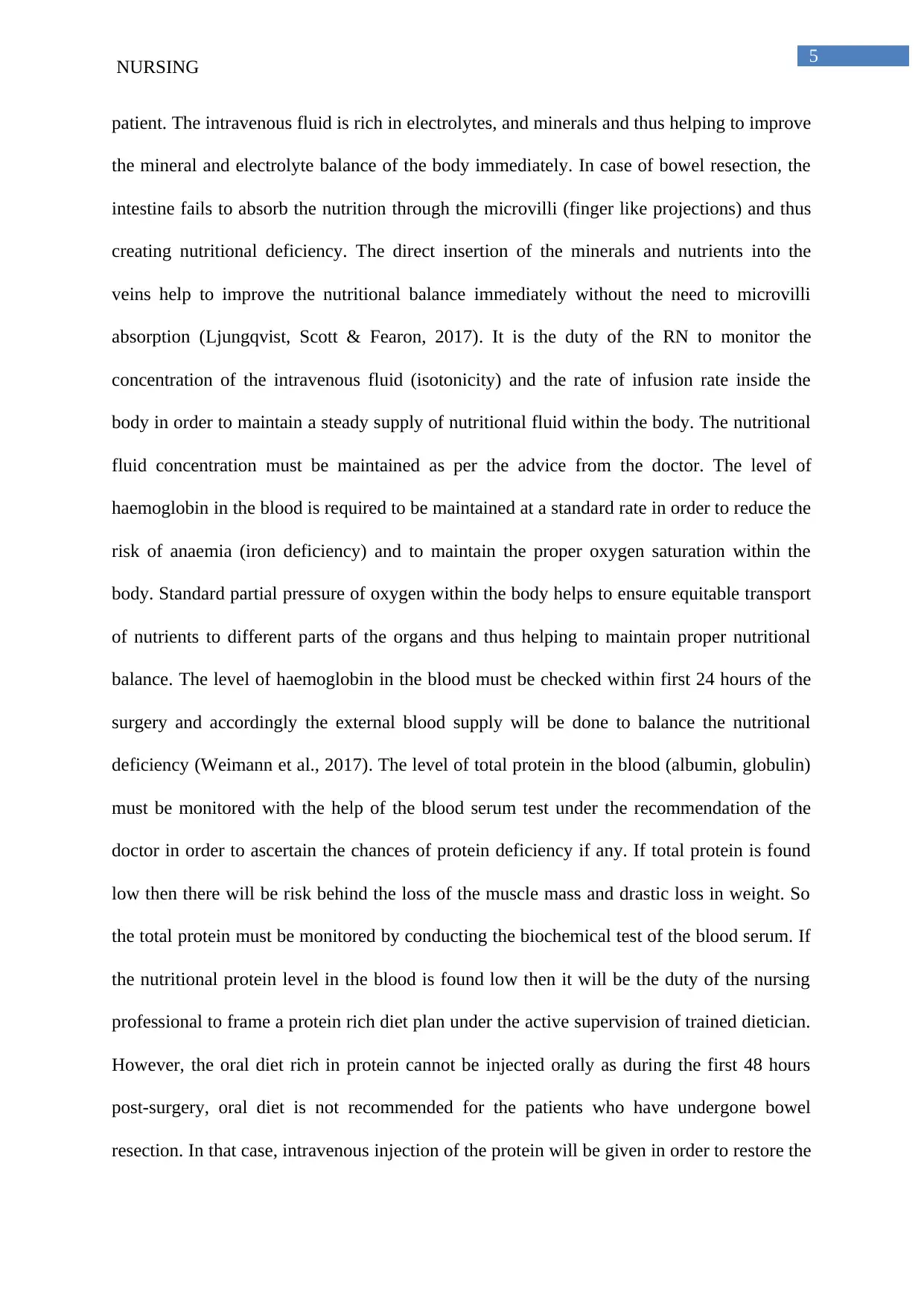
5
NURSING
patient. The intravenous fluid is rich in electrolytes, and minerals and thus helping to improve
the mineral and electrolyte balance of the body immediately. In case of bowel resection, the
intestine fails to absorb the nutrition through the microvilli (finger like projections) and thus
creating nutritional deficiency. The direct insertion of the minerals and nutrients into the
veins help to improve the nutritional balance immediately without the need to microvilli
absorption (Ljungqvist, Scott & Fearon, 2017). It is the duty of the RN to monitor the
concentration of the intravenous fluid (isotonicity) and the rate of infusion rate inside the
body in order to maintain a steady supply of nutritional fluid within the body. The nutritional
fluid concentration must be maintained as per the advice from the doctor. The level of
haemoglobin in the blood is required to be maintained at a standard rate in order to reduce the
risk of anaemia (iron deficiency) and to maintain the proper oxygen saturation within the
body. Standard partial pressure of oxygen within the body helps to ensure equitable transport
of nutrients to different parts of the organs and thus helping to maintain proper nutritional
balance. The level of haemoglobin in the blood must be checked within first 24 hours of the
surgery and accordingly the external blood supply will be done to balance the nutritional
deficiency (Weimann et al., 2017). The level of total protein in the blood (albumin, globulin)
must be monitored with the help of the blood serum test under the recommendation of the
doctor in order to ascertain the chances of protein deficiency if any. If total protein is found
low then there will be risk behind the loss of the muscle mass and drastic loss in weight. So
the total protein must be monitored by conducting the biochemical test of the blood serum. If
the nutritional protein level in the blood is found low then it will be the duty of the nursing
professional to frame a protein rich diet plan under the active supervision of trained dietician.
However, the oral diet rich in protein cannot be injected orally as during the first 48 hours
post-surgery, oral diet is not recommended for the patients who have undergone bowel
resection. In that case, intravenous injection of the protein will be given in order to restore the
NURSING
patient. The intravenous fluid is rich in electrolytes, and minerals and thus helping to improve
the mineral and electrolyte balance of the body immediately. In case of bowel resection, the
intestine fails to absorb the nutrition through the microvilli (finger like projections) and thus
creating nutritional deficiency. The direct insertion of the minerals and nutrients into the
veins help to improve the nutritional balance immediately without the need to microvilli
absorption (Ljungqvist, Scott & Fearon, 2017). It is the duty of the RN to monitor the
concentration of the intravenous fluid (isotonicity) and the rate of infusion rate inside the
body in order to maintain a steady supply of nutritional fluid within the body. The nutritional
fluid concentration must be maintained as per the advice from the doctor. The level of
haemoglobin in the blood is required to be maintained at a standard rate in order to reduce the
risk of anaemia (iron deficiency) and to maintain the proper oxygen saturation within the
body. Standard partial pressure of oxygen within the body helps to ensure equitable transport
of nutrients to different parts of the organs and thus helping to maintain proper nutritional
balance. The level of haemoglobin in the blood must be checked within first 24 hours of the
surgery and accordingly the external blood supply will be done to balance the nutritional
deficiency (Weimann et al., 2017). The level of total protein in the blood (albumin, globulin)
must be monitored with the help of the blood serum test under the recommendation of the
doctor in order to ascertain the chances of protein deficiency if any. If total protein is found
low then there will be risk behind the loss of the muscle mass and drastic loss in weight. So
the total protein must be monitored by conducting the biochemical test of the blood serum. If
the nutritional protein level in the blood is found low then it will be the duty of the nursing
professional to frame a protein rich diet plan under the active supervision of trained dietician.
However, the oral diet rich in protein cannot be injected orally as during the first 48 hours
post-surgery, oral diet is not recommended for the patients who have undergone bowel
resection. In that case, intravenous injection of the protein will be given in order to restore the
⊘ This is a preview!⊘
Do you want full access?
Subscribe today to unlock all pages.

Trusted by 1+ million students worldwide
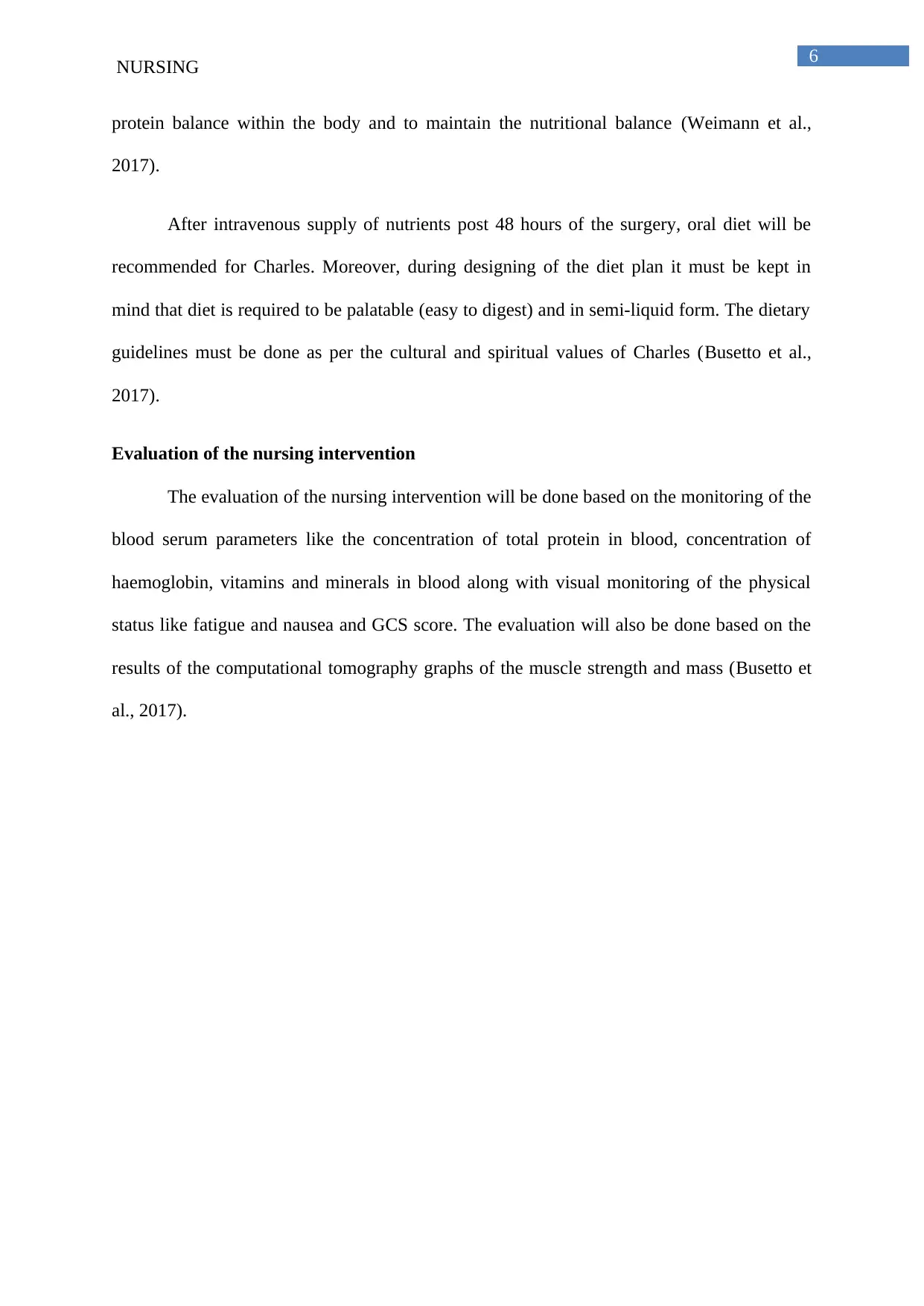
6
NURSING
protein balance within the body and to maintain the nutritional balance (Weimann et al.,
2017).
After intravenous supply of nutrients post 48 hours of the surgery, oral diet will be
recommended for Charles. Moreover, during designing of the diet plan it must be kept in
mind that diet is required to be palatable (easy to digest) and in semi-liquid form. The dietary
guidelines must be done as per the cultural and spiritual values of Charles (Busetto et al.,
2017).
Evaluation of the nursing intervention
The evaluation of the nursing intervention will be done based on the monitoring of the
blood serum parameters like the concentration of total protein in blood, concentration of
haemoglobin, vitamins and minerals in blood along with visual monitoring of the physical
status like fatigue and nausea and GCS score. The evaluation will also be done based on the
results of the computational tomography graphs of the muscle strength and mass (Busetto et
al., 2017).
NURSING
protein balance within the body and to maintain the nutritional balance (Weimann et al.,
2017).
After intravenous supply of nutrients post 48 hours of the surgery, oral diet will be
recommended for Charles. Moreover, during designing of the diet plan it must be kept in
mind that diet is required to be palatable (easy to digest) and in semi-liquid form. The dietary
guidelines must be done as per the cultural and spiritual values of Charles (Busetto et al.,
2017).
Evaluation of the nursing intervention
The evaluation of the nursing intervention will be done based on the monitoring of the
blood serum parameters like the concentration of total protein in blood, concentration of
haemoglobin, vitamins and minerals in blood along with visual monitoring of the physical
status like fatigue and nausea and GCS score. The evaluation will also be done based on the
results of the computational tomography graphs of the muscle strength and mass (Busetto et
al., 2017).
Paraphrase This Document
Need a fresh take? Get an instant paraphrase of this document with our AI Paraphraser
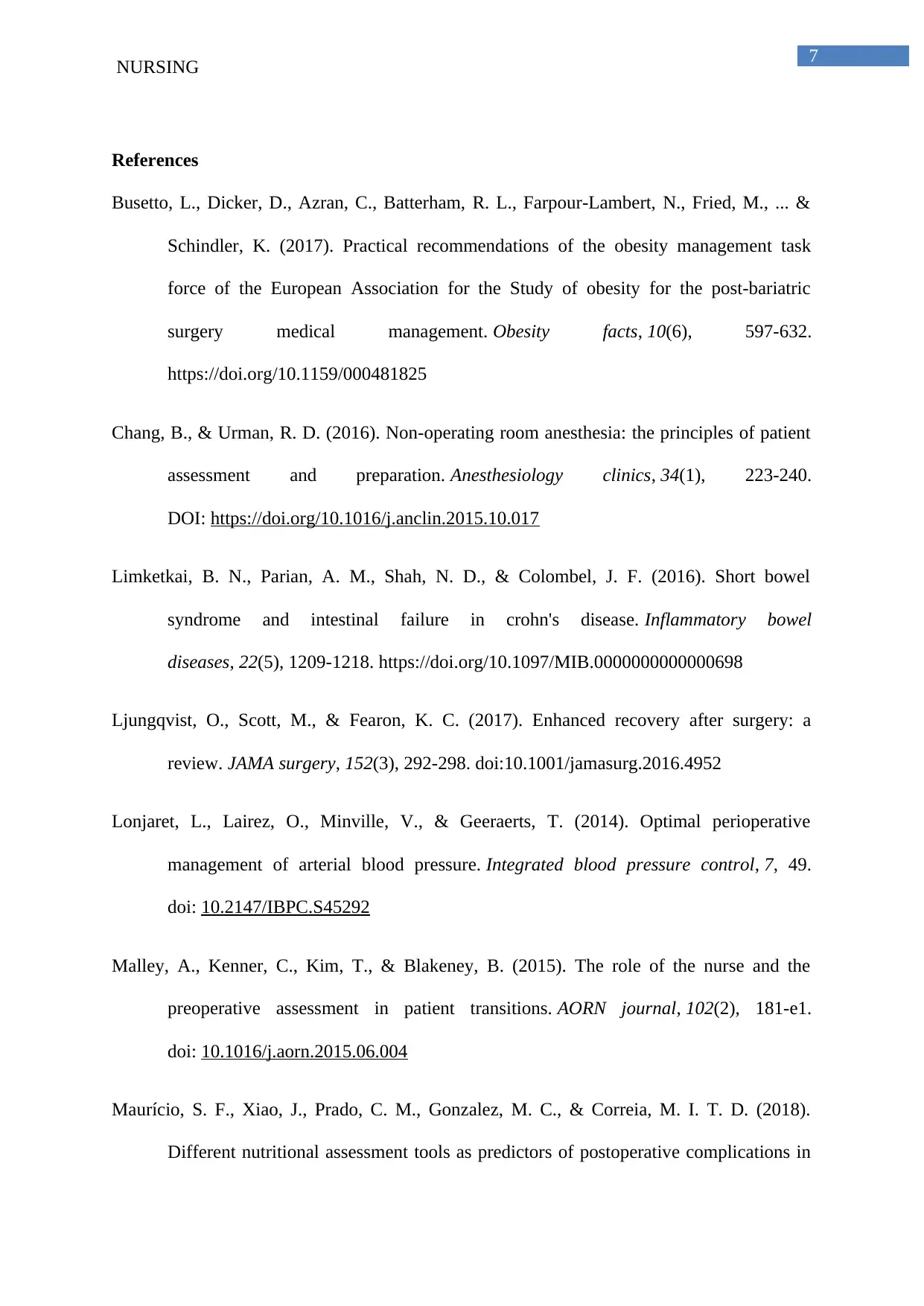
7
NURSING
References
Busetto, L., Dicker, D., Azran, C., Batterham, R. L., Farpour-Lambert, N., Fried, M., ... &
Schindler, K. (2017). Practical recommendations of the obesity management task
force of the European Association for the Study of obesity for the post-bariatric
surgery medical management. Obesity facts, 10(6), 597-632.
https://doi.org/10.1159/000481825
Chang, B., & Urman, R. D. (2016). Non-operating room anesthesia: the principles of patient
assessment and preparation. Anesthesiology clinics, 34(1), 223-240.
DOI: https://doi.org/10.1016/j.anclin.2015.10.017
Limketkai, B. N., Parian, A. M., Shah, N. D., & Colombel, J. F. (2016). Short bowel
syndrome and intestinal failure in crohn's disease. Inflammatory bowel
diseases, 22(5), 1209-1218. https://doi.org/10.1097/MIB.0000000000000698
Ljungqvist, O., Scott, M., & Fearon, K. C. (2017). Enhanced recovery after surgery: a
review. JAMA surgery, 152(3), 292-298. doi:10.1001/jamasurg.2016.4952
Lonjaret, L., Lairez, O., Minville, V., & Geeraerts, T. (2014). Optimal perioperative
management of arterial blood pressure. Integrated blood pressure control, 7, 49.
doi: 10.2147/IBPC.S45292
Malley, A., Kenner, C., Kim, T., & Blakeney, B. (2015). The role of the nurse and the
preoperative assessment in patient transitions. AORN journal, 102(2), 181-e1.
doi: 10.1016/j.aorn.2015.06.004
Maurício, S. F., Xiao, J., Prado, C. M., Gonzalez, M. C., & Correia, M. I. T. D. (2018).
Different nutritional assessment tools as predictors of postoperative complications in
NURSING
References
Busetto, L., Dicker, D., Azran, C., Batterham, R. L., Farpour-Lambert, N., Fried, M., ... &
Schindler, K. (2017). Practical recommendations of the obesity management task
force of the European Association for the Study of obesity for the post-bariatric
surgery medical management. Obesity facts, 10(6), 597-632.
https://doi.org/10.1159/000481825
Chang, B., & Urman, R. D. (2016). Non-operating room anesthesia: the principles of patient
assessment and preparation. Anesthesiology clinics, 34(1), 223-240.
DOI: https://doi.org/10.1016/j.anclin.2015.10.017
Limketkai, B. N., Parian, A. M., Shah, N. D., & Colombel, J. F. (2016). Short bowel
syndrome and intestinal failure in crohn's disease. Inflammatory bowel
diseases, 22(5), 1209-1218. https://doi.org/10.1097/MIB.0000000000000698
Ljungqvist, O., Scott, M., & Fearon, K. C. (2017). Enhanced recovery after surgery: a
review. JAMA surgery, 152(3), 292-298. doi:10.1001/jamasurg.2016.4952
Lonjaret, L., Lairez, O., Minville, V., & Geeraerts, T. (2014). Optimal perioperative
management of arterial blood pressure. Integrated blood pressure control, 7, 49.
doi: 10.2147/IBPC.S45292
Malley, A., Kenner, C., Kim, T., & Blakeney, B. (2015). The role of the nurse and the
preoperative assessment in patient transitions. AORN journal, 102(2), 181-e1.
doi: 10.1016/j.aorn.2015.06.004
Maurício, S. F., Xiao, J., Prado, C. M., Gonzalez, M. C., & Correia, M. I. T. D. (2018).
Different nutritional assessment tools as predictors of postoperative complications in
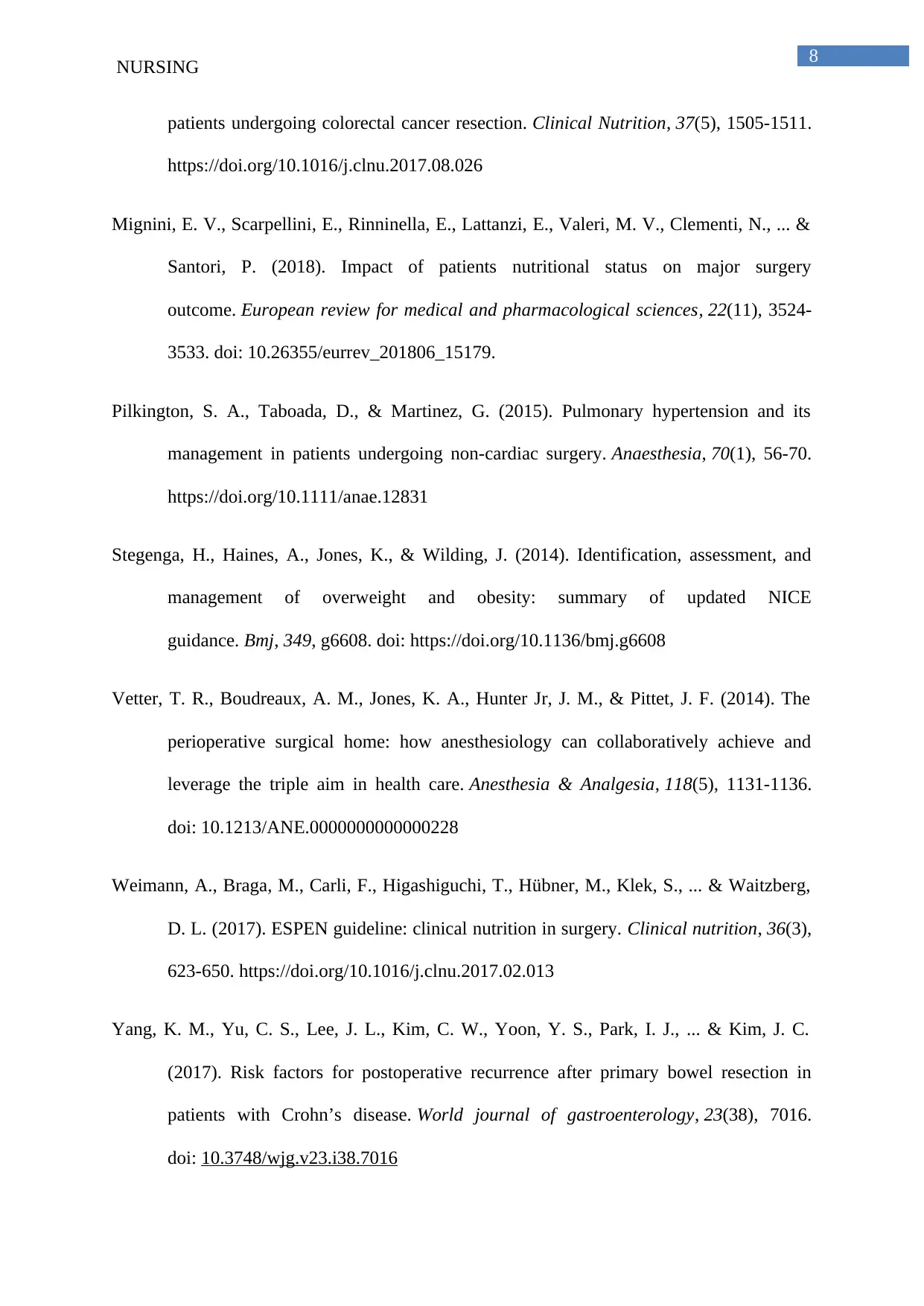
8
NURSING
patients undergoing colorectal cancer resection. Clinical Nutrition, 37(5), 1505-1511.
https://doi.org/10.1016/j.clnu.2017.08.026
Mignini, E. V., Scarpellini, E., Rinninella, E., Lattanzi, E., Valeri, M. V., Clementi, N., ... &
Santori, P. (2018). Impact of patients nutritional status on major surgery
outcome. European review for medical and pharmacological sciences, 22(11), 3524-
3533. doi: 10.26355/eurrev_201806_15179.
Pilkington, S. A., Taboada, D., & Martinez, G. (2015). Pulmonary hypertension and its
management in patients undergoing non‐cardiac surgery. Anaesthesia, 70(1), 56-70.
https://doi.org/10.1111/anae.12831
Stegenga, H., Haines, A., Jones, K., & Wilding, J. (2014). Identification, assessment, and
management of overweight and obesity: summary of updated NICE
guidance. Bmj, 349, g6608. doi: https://doi.org/10.1136/bmj.g6608
Vetter, T. R., Boudreaux, A. M., Jones, K. A., Hunter Jr, J. M., & Pittet, J. F. (2014). The
perioperative surgical home: how anesthesiology can collaboratively achieve and
leverage the triple aim in health care. Anesthesia & Analgesia, 118(5), 1131-1136.
doi: 10.1213/ANE.0000000000000228
Weimann, A., Braga, M., Carli, F., Higashiguchi, T., Hübner, M., Klek, S., ... & Waitzberg,
D. L. (2017). ESPEN guideline: clinical nutrition in surgery. Clinical nutrition, 36(3),
623-650. https://doi.org/10.1016/j.clnu.2017.02.013
Yang, K. M., Yu, C. S., Lee, J. L., Kim, C. W., Yoon, Y. S., Park, I. J., ... & Kim, J. C.
(2017). Risk factors for postoperative recurrence after primary bowel resection in
patients with Crohn’s disease. World journal of gastroenterology, 23(38), 7016.
doi: 10.3748/wjg.v23.i38.7016
NURSING
patients undergoing colorectal cancer resection. Clinical Nutrition, 37(5), 1505-1511.
https://doi.org/10.1016/j.clnu.2017.08.026
Mignini, E. V., Scarpellini, E., Rinninella, E., Lattanzi, E., Valeri, M. V., Clementi, N., ... &
Santori, P. (2018). Impact of patients nutritional status on major surgery
outcome. European review for medical and pharmacological sciences, 22(11), 3524-
3533. doi: 10.26355/eurrev_201806_15179.
Pilkington, S. A., Taboada, D., & Martinez, G. (2015). Pulmonary hypertension and its
management in patients undergoing non‐cardiac surgery. Anaesthesia, 70(1), 56-70.
https://doi.org/10.1111/anae.12831
Stegenga, H., Haines, A., Jones, K., & Wilding, J. (2014). Identification, assessment, and
management of overweight and obesity: summary of updated NICE
guidance. Bmj, 349, g6608. doi: https://doi.org/10.1136/bmj.g6608
Vetter, T. R., Boudreaux, A. M., Jones, K. A., Hunter Jr, J. M., & Pittet, J. F. (2014). The
perioperative surgical home: how anesthesiology can collaboratively achieve and
leverage the triple aim in health care. Anesthesia & Analgesia, 118(5), 1131-1136.
doi: 10.1213/ANE.0000000000000228
Weimann, A., Braga, M., Carli, F., Higashiguchi, T., Hübner, M., Klek, S., ... & Waitzberg,
D. L. (2017). ESPEN guideline: clinical nutrition in surgery. Clinical nutrition, 36(3),
623-650. https://doi.org/10.1016/j.clnu.2017.02.013
Yang, K. M., Yu, C. S., Lee, J. L., Kim, C. W., Yoon, Y. S., Park, I. J., ... & Kim, J. C.
(2017). Risk factors for postoperative recurrence after primary bowel resection in
patients with Crohn’s disease. World journal of gastroenterology, 23(38), 7016.
doi: 10.3748/wjg.v23.i38.7016
⊘ This is a preview!⊘
Do you want full access?
Subscribe today to unlock all pages.

Trusted by 1+ million students worldwide
1 out of 9
Related Documents
Your All-in-One AI-Powered Toolkit for Academic Success.
+13062052269
info@desklib.com
Available 24*7 on WhatsApp / Email
![[object Object]](/_next/static/media/star-bottom.7253800d.svg)
Unlock your academic potential
Copyright © 2020–2025 A2Z Services. All Rights Reserved. Developed and managed by ZUCOL.





